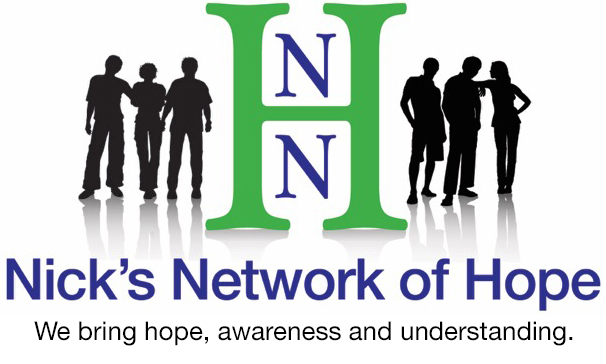Reasons to Stop Self Injury (Includes Cutting)
- Experiencing only short term relief that leads to further feelings of guilt and shame; thereby keeping you from learning how to cope with your problems in a healthy way
- Keeping the “secret” from family and friends is very difficult and isolating
- Risking cutting yourself accidentally too deeply or hurting yourself more than intended and risking infection
- Needing to learn the appropriate way to cope with emotional pain to lower the risk of major depression, drug and alcohol addictions, and suicide.
- Risking self-injuring turning into a compulsive behavior; so instead of doing it to gain control of the pain, self-harming begins to control your life 1

Love Yourself
Confide in Someone
If you are ready to get help, strongly consider telling someone about your cutting or self-injury. Sharing may seem scary after hiding it from others for so long. Remember, it is best to confide with an adult rather than a friend because an adult is less likely to spread gossip about your situation. What adult in your life do you trust and respect? It can be a parent, teacher, coach, school counselor, or religious leader, for example. This person doesn’t need to be really close to you. A more distant adult may be more objective and less emotional than someone extremely close to you. In any case, the adult should be someone you trust and respect. 2
Tips when Talking
Communicate in a way that makes you feel most comfortable when talking with the adult. You can begin with an email, text, or letter, but be prepared to eventually sit down and talk face to face about your cutting or self-harm.
Make it clear why you are seeking their help from the very start. Communicate if you only wish to share your secret with them and want them to keep it confidential – or- if you want them to give you advice and assistance finding professional help.
Keep the focus on your feelings and not on the intimate details of the process of injuring. The adult needs to know what triggers you to cut or self-harm (what emotions you are feeling that lead you to self-harm) so they can better help you.
Give the adult time to process what you tell them. They may experience emotions or need some time to think about options of how to better help you. Any emotions they experience are out of concern for you, so give them their time. If they are not familiar with cutting or self-harm, print out articles on the topic so they can educate themselves to assist you better.3

You are Beautiful Inside and Out
Try to Understand Why You Cut
What emotion do you feel before you decide to cut or self injure? Are you feeling sadness, anger, disappointment, fear, guilt, shame, loneliness, numbness, stress – or some other emotion? A professional therapist can assist you in determining what emotion(s) trigger your cutting or self-harm. 4
Alternative Coping Techniques
Instead of cutting to express pain and other intense emotions, try to:
- Express your feelings in a journal
- Listen to music that allows you to release these emotions
- Paint or draw images that express your feelings
- Compose poetry or a song—or—write a story that expresses how you feel
Instead of cutting to release tension or vent anger, try to:
- Exercise by doing an activity vigorously, like running, kickboxing, dancing, etc.
- Yell into a pillow or punch a cushion
- Squeeze a handheld stress ball
- Rip sheets of paper or a magazine
- Make noise by playing an instrument, sounding a noisemaker, or banging on pots and pans
Instead of cutting to calm and soothe yourself, try to:
- Listen to soothing music
- Learn to meditate
- Take a warm bath or shower
- Cuddle with a pet dog or cat
Instead of cutting because you feel disconnected and numb, try to:
- Reach out to a friend or family member (don’t have to talk about self-harm)
- Go online to a support chat room specifically designed to help. Call NAMI’s (National Alliance on Mental Health) Helpline in the U.S. at (800) 950-6264 for referrals and support in choosing a safe online chat resource
- Try holding an ice cube to the bend of your arm or behind your knee 5

Reach Out for Help if You Feel the Need to Cut
Seeking Professional Help and Support
Know that help is available and that you are not alone. Treatment is available for people who injure themselves. It is always a good idea to try to get professional help and support to assist you in trying to break the habit of self-harming. A good therapist can help you better identify why you are doing so, and assist you in learning better coping strategies for the long term. Instead of giving yourself a quick “fix” in a harmful way, you can learn a much healthier way to cope. If your self-harm is connected to some issue from your childhood, the therapist can help you with that underlying cause so you can move forward in a positive direction.
Finding the right therapist is essential in the healing process. Look for someone who specializes in both trauma and self-injury. After some time, if you find that you do not feel comfortable with a therapist you have chosen, follow your intuition and choose another one. Keep looking until you find a therapist you feel a sense of trust and confidence with at all times. This is a difficult time in your life, but with help, you can get to a point where you don’t hurt yourself anymore. 6
Helping a Friend or Family Member who Self-Injures
- Ask about it. Your friend or family member may be relieved if you bring it up so he/she can finally talk about it. If you’re wrong, you will not give him/her the idea to do it.
- Deal with your Feelings. You may feel shocked, disgust, fear, anger, or many other emotions when learning about your loved one’s self-harming. Step back and get in control of your feelings so you can better help your friend or family member.
- Educate yourself. Learning the different reasons why people self-harm and other facts about it is essential in better understanding the person you care about and how they view the world. Know they are not doing it for attention. Go to our Resources Page for online sources.
- Don’t Judge. Avoid criticizing your friend or family member because they already hurt, feel alone, and need help.
- Offer Support, not Ultimatums. Punishing or threatening your loved one will only make them feel more isolated, pain, shame, and fear. They need to feel safe, secure, love, and support. Tell them you are always there willing to talk and give support.
- Encourage Communication. It is essential that the person who is self-harming knows you care and are open for them to express their feelings to you, even if you are uncomfortable with it. Encourage honesty and open communication. If the person hasn’t told you about the self-harm, bring up the subject in a caring, non-confrontational way: “I’ve noticed injuries on your body, and I want to understand what you’re going through.”
- Seek Support. Especially if you are a teen and notice a friend self-harming, consider telling a teacher or other trusted adult. This is a stressful time for both of you. You may feel you shouldn’t tell anyone, but you are helping get someone you care about the help that is needed. See our Resources page for helplines to talk to someone who can help you decide where to turn for assistance.
- Encourage Professional Help. Offer to assist your friend or family member in finding professional help. Be patient with your loved one if they want to change therapists. Finding the right one may take some time. If the self-harmer is a family member, especially if it is your child, prepare yourself to address difficulties in the family. This is not about blame, but rather about learning ways of dealing with problems and communicating better so to help the whole family. 7
Additional Information
MayoClinic.org Self-Injury/Cutting Information is a link with more information about self-injury/cutting, including overview, symptoms, causes, complications, treatments, how to prepare for your appointment, self-management (to be done in addition to professional treatment), coping & support and prevention.
FREE, Downloadable Self-Injury FactSheets, Leaflets, ebooks, and Print-Outs
Go to lifesigns.org.uk for downloadable factsheets titled “Parents & Guardians,” “Friends,” “Males,” “For People Who Self Injure,” “Healthcare Workers,” “Teacher & Lecturers,” and “Employers”); a FREE, downloadable 50 pg. book (LifeSIGNS Self Injury Awareness Booklet – Information for Health Care Workers, Family, Friends, and Teachers of People Who Self Harm); a FREE downloadable ebook titled “The LifeSigns little book of five a days” (contains different ideas for health and happiness; and a 2-pg handout titled the “Precursors to Self-Injury.”
The lifesigns.org.uk website (link above) also contains a lot of information for the individuals who self-harm, guidance for others, blog articles, and personal stories.
- HelpGuide.org. Retrieved from https:// www.helpguide.org/ anxiety/cutting-and-self-harm.htm (with permission) ↩
- HelpGuide.org. Retrieved from http://www.helpguide.org/anxiety/cutting-and-self-harm.htm (with permission) ↩
- HelpGuide.org. Retrieved from http://www.helpguide.org/anxiety/cutting-and-self-harm.htm (with permission) ↩
- HelpGuide.org. Retrieved from http://www.helpguide.org/anxiety/cutting-and-self-harm.htm (with permission) ↩
- HelpGuide.org. Retrieved from http://www.helpguide.org/anxiety/cutting-and-self-harm.htm (with permission) ↩
- HelpGuide.org. Retrieved from http://www.helpguide.org/anxiety/cutting-and-self-harm.htm (with permission) ↩
- HelpGuide.org. Retrieved from http://www.helpguide.org/anxiety/cutting-and-self-harm.htm (with permission) ↩
